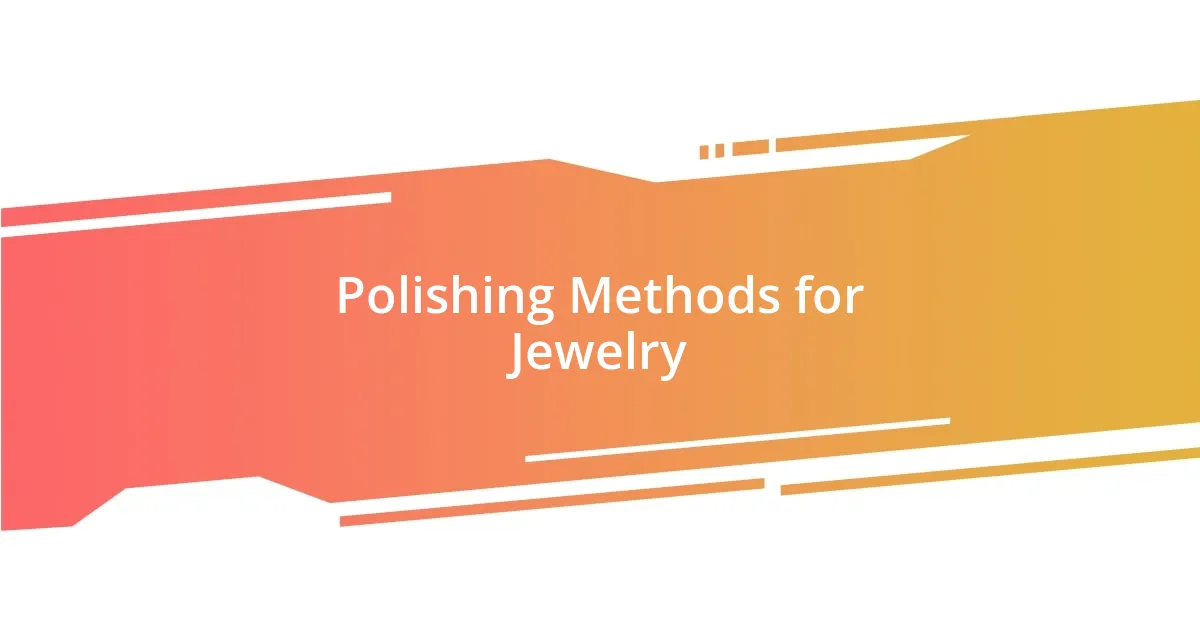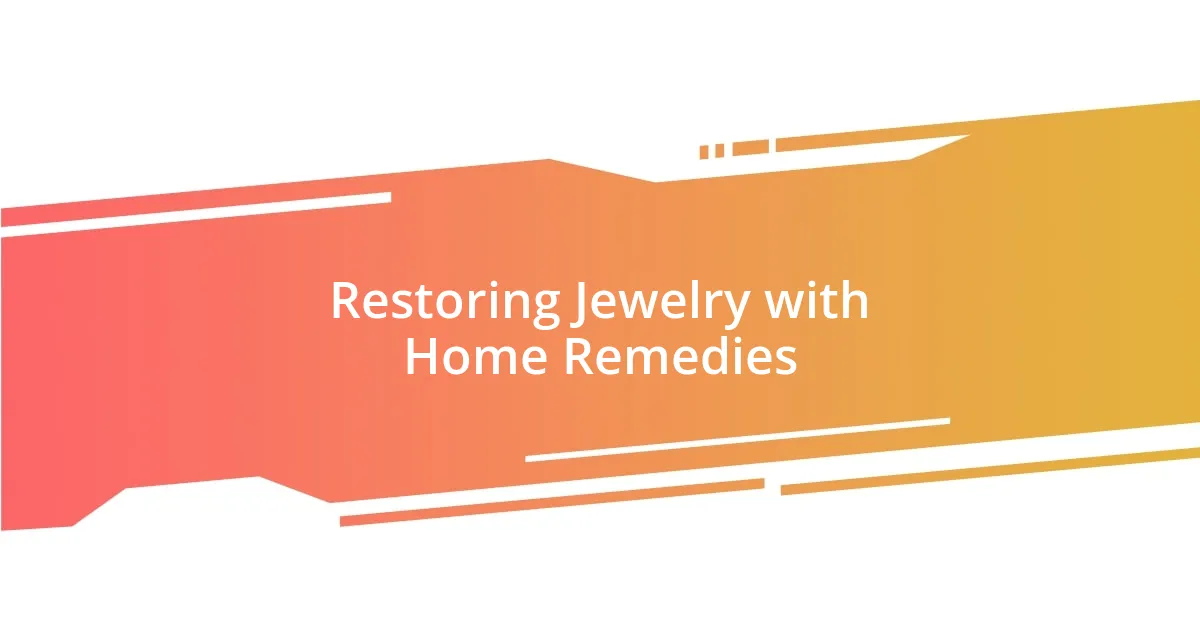Key takeaways:
- Jewelry dullness is caused by skin oils, oxidation, and improper storage, requiring regular cleaning and care.
- Effective cleaning methods include using mild soap and water, jewelry cleaners, and polishing cloths to restore shine.
- Home remedies like baking soda paste, white vinegar, and lemon juice can effectively revive dull jewelry.
- Professional help is recommended for significant damage or valuable heirlooms, ensuring proper care and restoration.

Understanding Jewelry Dullness
Have you ever noticed how your once-sparkling jewelry can lose its brilliance over time? It’s something I’ve experienced first-hand, especially with my favorite silver necklace. I wore it nearly every day, and eventually, it seemed to lose its luster due to skin oils, dirt, and even exposure to harsh chemicals. It’s intriguing how seemingly minor factors can lead to noticeable dullness.
Each piece of jewelry tells a story, but that story can sometimes get clouded by neglect and wear. I remember feeling a pang of disappointment when I looked at my beloved earrings and realized they had become dull. That sadness reminded me of the importance of regular cleaning and care—something we often overlook amidst our busy lives. How often do we pause to consider how our daily habits affect the treasures we wear?
Understanding the causes of jewelry dullness is essential for maintaining its beauty. Just like any cherished possession, jewelry requires attention. The layer of grime can be so subtle that we might not even notice it until we hold it up to the light. How about taking a closer look at your own collection? You might find pieces that need a little revival, waiting to shine again.

Common Causes of Dull Jewelry
Jewelry dullness often stems from everyday wear and tear, which might surprise many. When I think about my own collection, it’s easy to forget just how much friction and exposure to elements my jewelry endures. Over time, exposure to lotions, perfumes, and even perspiration can create a dull film that masks the piece’s original shine—a lesson I learned the hard way when a stunning bracelet of mine became almost unrecognizable.
Another common cause of dullness is the natural oxidation process, especially with metals like silver. I once owned a beautiful silver ring that began to tarnish despite my best efforts to keep it polished. This oxidation occurs when the metal reacts with sulfur and moisture in the air. It’s a bit of a heart-wrencher when something you love is gradually losing its charm, isn’t it?
Lastly, jewelry can accumulate dirt and dust, especially when stored improperly. I remember the frustration of discovering a lovely necklace tangled up in my jewelry box, coated in dust. This residue dulls the shine and can even scratch the surface of delicate pieces. Have you ever taken a moment to reflect on how you care for your jewelry? I’ve found that simple changes in storage and cleaning habits can make all the difference.
| Causes of Dull Jewelry | Details |
|---|---|
| Skin Oils and Dirt | Everyday exposure to skin oils and dirt creates a film that dulls the surface. |
| Oxidation | Chemical reactions with air can cause tarnishing, especially in silver. |
| Improper Storage | Dirt accumulation and scratching from tangled storage can lead to a lackluster appearance. |

Effective Cleaning Techniques
When it comes to reviving dull jewelry, I’ve discovered that effective cleaning techniques can make a world of difference. One method I often turn to involves gentle soap, warm water, and a soft toothbrush. I remember the first time I tried this technique on my engagement ring, which had lost its sparkle after years of wear. With a little patience, I was amazed at how the grime faded away, revealing the glistening beauty beneath.
Here are some practical tips to keep in mind:
- Soap and Water: Mix mild dish soap with warm water and soak your jewelry for 15-20 minutes. Use a soft-bristled brush to gently scrub.
- Jewelry Cleaner: Invest in a commercially available cleaner specifically designed for your jewelry type. Follow the instructions carefully.
- Polishing Cloth: For metals like silver and gold, a polishing cloth can remove tarnish and enhance shine without harsh chemicals.
In my experience, avoiding harsh chemicals is key. I once mistakenly used a cleaner that was too abrasive on my favorite gold hoop earrings, leading to scratches that made me cringe every time I looked at them. Sticking to gentler methods has been a lesson learned the hard way, but it’s one that pays off every time I see my jewelry regain its original brilliance.

Polishing Methods for Jewelry
Polishing jewelry can feel like breathing new life into pieces that have lost their luster. A method that resonates with me is using a simple baking soda paste. I vividly remember attempting this on an old charm bracelet that I cherished. Mixing baking soda with a little water to form a paste and gently applying it with a soft cloth was transformative—it not only eliminated tarnish but also felt deeply satisfying to see it shine again. Have you ever felt that thrill when a beloved piece comes back to life?
Another method I often recommend involves using specific polishing cloths designed for different metal types. When I used a gold polishing cloth on my grandmother’s vintage locket, I was struck by how effortlessly the grime came off. It was as if the cloth knew exactly what to do. Have you considered how a simple cloth can turn your lackluster jewelry into something that sparkles with memories?
For those pieces that require a little more elbow grease, I suggest using a silver or gold cleaner followed by a gentle rinse and drying. Once, I had a set of silver earrings that looked almost dull enough to toss. After a quick dip in cleaner and a soft cloth polish, they went from forgotten to fabulous. Seeing the transformation reminded me just how much a little attention can enhance not only the jewelry but also my mood. How do you feel when your treasures regain their shine?

Restoring Jewelry with Home Remedies
Restoring jewelry with home remedies can be both simple and fulfilling. One time, I had a set of pearl earrings that seemed lackluster and forgotten in my jewelry box. I decided to try a mixture of water and a few drops of baby shampoo, and after soaking them for a short while, the transformation was astonishing. It was like unveiling a hidden treasure that I couldn’t wait to wear again.
Another effective method I often utilize involves the power of white vinegar combined with baking soda. I remember the excitement of using this remedy on a tarnished silver ring that I inherited from my mom. The fizzing reaction as I mixed the two ingredients was oddly satisfying, and when I rinsed and dried the ring, it sparkled just like the day I received it. Have you ever watched a piece of jewelry come back to life and felt that rush of nostalgia?
Additionally, I’ve had great success with using olive oil and lemon juice for restoring the shine on my gold jewelry. One afternoon, I mixed these ingredients, applied the solution with a soft cloth, and could hardly contain my delight as the lovely hue of the gold reemerged. It’s incredible how these everyday items can give your jewelry a second chance, isn’t it? Each piece tells a story, and reviving them not only brightens their appearance but also rekindles cherished memories for me.

Preventing Future Dullness
To prevent future dullness in your jewelry, careful storage and maintenance are essential. I learned the hard way that keeping pieces in a fabric-lined box instead of tossing them into a drawer makes a world of difference. Those little compartments not only shield jewelry from scratches but also keep pieces from tangling, which can contribute to their dull appearance over time. Have you ever found yourself untangling a mess of chains and wished you’d stored them differently?
Regular cleaning can also help maintain that lovely shine. I make a point to clean my favorite rings after wearing them, especially if I’ve used lotions or perfumes. Just a quick wipe with a soft cloth can eliminate residue before it builds up. It’s a simple habit that saves me from bigger polishing jobs later. Has there been a moment when you felt the burden of neglecting a cherished piece?
Lastly, be mindful of when and how you wear your jewelry. On several occasions, I’ve removed my earrings before cooking or exercising because I know the sweat or splatters can cause dullness. In fact, I noticed my favorite bracelet stayed vibrant longer after I made it a rule to take it off during certain activities. How often do you think about the impact of your daily routines on your jewelry’s appearance?

When to Seek Professional Help
Sometimes, despite our best efforts, jewelry may remain dull or damaged. In those moments, I’ve learned it’s best to seek professional help. I remember the first time I took my grandmother’s vintage locket to a jeweler; the expert not only cleaned it but also repaired a small hinge that I didn’t even notice was broken. That sense of reassurance from someone who truly understands how to preserve such sentimental pieces is priceless. Have you ever thought about the expertise that professionals bring to delicate repairs?
If you find your jewelry has significant scratches, crevices, or discoloration that home remedies can’t fix, it might be time to consult an expert. There were times I hesitated, thinking I could tackle everything myself, but I quickly realized that specialized techniques and tools make all the difference. The right cleaning solutions can revive a stone’s brilliance in ways I never could at home.
Finally, if your jewelry possesses any valuable gemstones or is an heirloom piece, getting professional advice is crucial. I recall chatting with a gemologist at a local shop who explained the specific care that my opal ring needed to prevent damage. Their insights not only safeguarded the piece but also deepened my appreciation for its beauty. How often do we overlook vital information that can prevent future mishaps in our cherished items?















